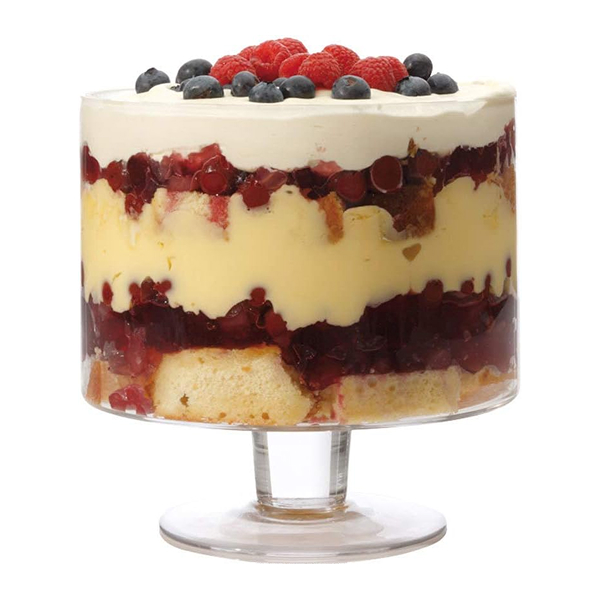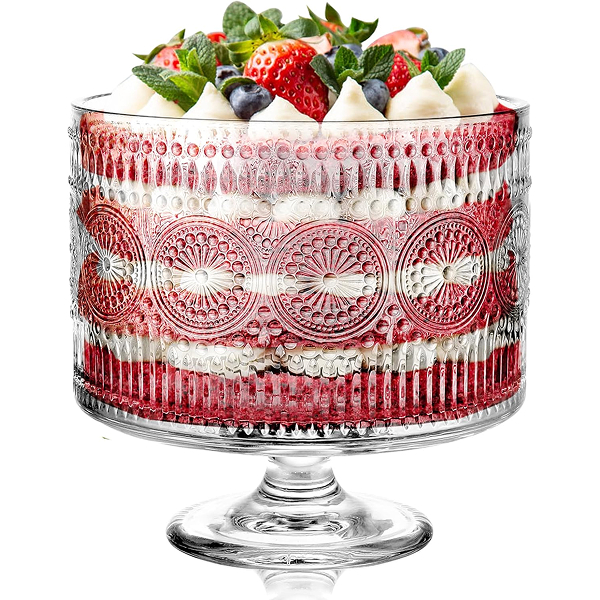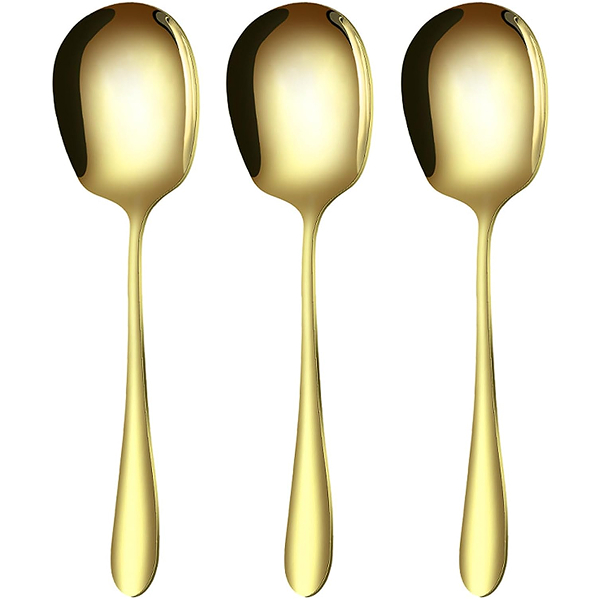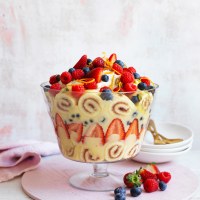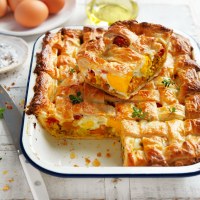Indulgent Christmas trifles made with real custard
Christmas is a time to let loose a little, a time to enjoy treats without guilt. It's also a time to put the love into your food, so why not whip up a homemade custard and take your trifle to the next level? No matter what size, flavoured jelly or sponge cake you plan on making, the essential ingredient is a good custard. It brings all the other components together.
A creamy, egg-rich custard doesn’t have to be a Christmas treat; it can be enjoyed year-round. It’s a perfect partner for apple pies, crumbles and warm chocolate puddings. And it’s not as hard as you may think. You only need a few pantry staple ingredients - eggs, milk, flour, vanilla and sugar to make a custard that's delicious, economical and easy.
Custard ingredients
Different custard recipes will call for differing quantities of ingredients, but if you have these on hand, you'll be ready to make almost any custard:
- Cream
Use a pure whipping cream with a fat content of about 36%. Avoid thickened or double cream. - Milk
Equal quantities of cream and milk will produce a rich, velvety and smooth custard. Some recipes will use either all cream or all milk. - Spices
Whole spices such as cloves and cinnamon sticks are ideal to use when infusing the cream and milk, as they can be strained out and are less likely to colour the custard like ground spices can do. However, if you only have ground spices, these can be used. Just be aware they are likely to change the colour of the custard slightly but don't let that put you off; when the trifle is layered, you'll hardly notice. Add spices to the cold cream/milk mixture and then heat slowly, stirring often. Leave spices in while cooking the custard to infuse more flavour. - Eggs
Egg yolks are essential for thickening the custard and providing flavour. Some custards (crème anglaise) only use egg yolks as the main thickening agent, but adding a little cornflour helps stabilise the custard, making it less likely to overcook and curdle the egg. Whisking the egg yolks and sugar together helps dissolve the sugar and begins the cooking process of the eggs. It is essential to add the warmed milk slowly, which helps to raise their eggs’ temperature without cooking them. - Cornflour
Cornflour helps thicken and stabilise custard, making it less likely to curdle if cooked at a higher temperature or left to cook for longer. Adding starch is also ideal for reducing the cooking time and gives you more control over your preferred thickness of the custard. You can use any fine starch such as tapioca or rice starch, to make the custard. - Sugar
Use white or caster sugar. You can use brown sugar or other sugars, but they will significantly change the flavour and colour. You don't need much sugar to sweeten custard, so if you're not sure how sweet the custard will be, start with less and add more later.
The equipment you need to make custard
- A saucepan large enough to contain the mixture with room enough for stirring.
- A long-handled wooden spoon for stirring the custard as it cooks.
- A large fine sieve for straining the custard.
Tips for cooking creamy custard. When you know the basics, you'll be making custard all the time!
1. Warming and infusing the milk
Warming the milk and cream mixture with spices not only shortens the overall cook time of the custard but it will help infuse the spices and vanilla into the milk, giving a richer flavour. Heat the milk to just below boiling. Stir occasionally while this is happening to prevent the milk from scorching on the base of the saucepan.
A good indication that the milk mixture is at temperature is when tiny bubbles start appearing around the sides of the saucepan. At that moment, your milk is ready. Don't boil the milk - if this happens, it will change the flavour of your custard, so it should be discarded.
2. Bring the egg yolks to the ribbon stage
Beat egg yolks and sugar together with a whisk. The mixture should become pale in colour and thicken up substantially, and the sugar should begin to dissolve.
You know the egg mixture is ready when it forms ribbons as you lift the whisk from the mixture and the batter falls back in thick trails. The ribbon lines will stay suspended on top of the batter and remain visible on the surface for a few moments before slowly disappearing. This tip ensures the eggs and sugar are correctly incorporated so the custard will be smooth and creamy, not lumpy.
3. Avoid scrambled eggs
Tempering is the technical term for adding the hot milk and cream mixture to egg yolks. This process is very important, as it stops the eggs from overheating and curdling. Place a tea towel underneath the bowl to stabilise it while whisking. Add about ½ cup of warm milk to the eggs, whisking continuously.
Once the milk has been incorporated, add double the amount of heated milk and whisk well. Return the combined mixture to the saucepan with remaining milk and heat gently over medium-low heat. Keep stirring continuously, this helps to distribute the heat, avoiding hot spots which can curdle the mixture.
4. How to know when the custard is cooked
Cook the custard, stirring constantly. Don't allow it to come to a boil. To check your custard is thick enough, draw a finger across the back of the spoon. If it leaves a trail, your custard is ready.
5. Cooling the custard
The custard must be cooled quickly to stop the eggs from continuing to cook. The easiest way to do this is to pour the custard into a clean bowl or jug. Cover with plastic wrap to stop skin from forming, and refrigerate immediately. Custards will thicken dramatically on cooling.
Do I need to strain my custard?
Yes. Once the custard has been cooked, immediately strain it through a fine sieve into a jug or bowl. This removes any lumps of egg and whole spices to produce a smooth custard.
How to use custard in a trifle
You always want to use cooled custard in your trifle. Fifteen minutes before layering your trifle, remove the custard from the refrigerator and get it to room temperature. Whisk gently so that it has the consistency of whipped cream. This will make it easier to dollop and spread the custard layer.
Trifle recipes
Now that you’ve got the roadmap to a great custard, it’s time to get whisking and layer it up for an indulgent trifle.
GET THE RECIPE: Tipsy Eggnog Trifle by Australian Eggs
This trifle uses custard spiced with cloves, nutmeg and cinnamon for a truly indulgent dessert that's worthy of Christmas with the family.
GET THE RECIPE: Easy Custard Berry Trifle by Australian Eggs
Simple but classic, this trifle with vanilla custard makes use of the summer berries that are abundant during Australian Christmases.
GET THE RECIPE: Epic raspberry trifle with meringue top by Australian Eggs
Not sure what to do with the extra egg whites from your custard? This trifle makes use of them in a towering meringue topping.





